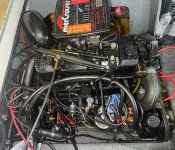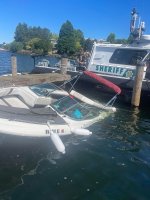pseudomode
New member
I have been sifting through this forum for the past month trying to solve this issue and it has me baffled. I've learn WAY more about this engine than I ever wanted to learn but I haven't learned how to fix this problem. Perhaps someone here can help.
Short story:
I got a call from the marina that my 1992 Sea Ray bowrider 180 was mostly underwater. When I got there, the entire engine and back half of the boat was underwater. The only thing holding it up was the dock lines. After 3 hours and help of the amazing marine division of the local police department, we were able to raise and pump the boat long enough to tow it to ramp and onto my trailer.
When I got the boat home, I did all the things you do to get water out of the engine and all the other systems (no need to go through it all). I started the engine and it ran great. Relieved, I went on vacation. Returned and it wouldn't start. It turns over but no fire.
Replaced:
Please let me know what I'm missing here. I've reached my limit of self-sufficiency and need some professional advise. I'm determined to fix this darn thing before winter!
Short story:
I got a call from the marina that my 1992 Sea Ray bowrider 180 was mostly underwater. When I got there, the entire engine and back half of the boat was underwater. The only thing holding it up was the dock lines. After 3 hours and help of the amazing marine division of the local police department, we were able to raise and pump the boat long enough to tow it to ramp and onto my trailer.
When I got the boat home, I did all the things you do to get water out of the engine and all the other systems (no need to go through it all). I started the engine and it ran great. Relieved, I went on vacation. Returned and it wouldn't start. It turns over but no fire.
Replaced:
- carburetor
- fuel pump/fuel filter
- spark plugs
- plug wires
- distributor cap/rotor
- ignition coil
- ignition module
- starter
- oil pressure sensor
- tilt/trim solenoid
- all fuses
- battery
- Plugs are getting spark (timing light test)
- No water in the gas tank (drained/replaced)
- Starter cranks the engine, no fire
- fuel it reaching the carb.
- Passes compression test (125lbs for each cylinder)
- checked voltage and continuity on all the ignition wires and harnesses
- possibly more I'm not thinking of
Please let me know what I'm missing here. I've reached my limit of self-sufficiency and need some professional advise. I'm determined to fix this darn thing before winter!



